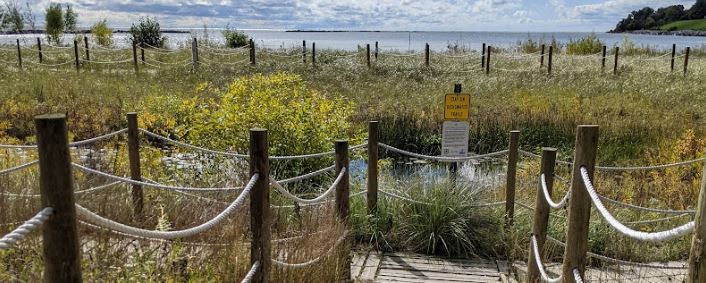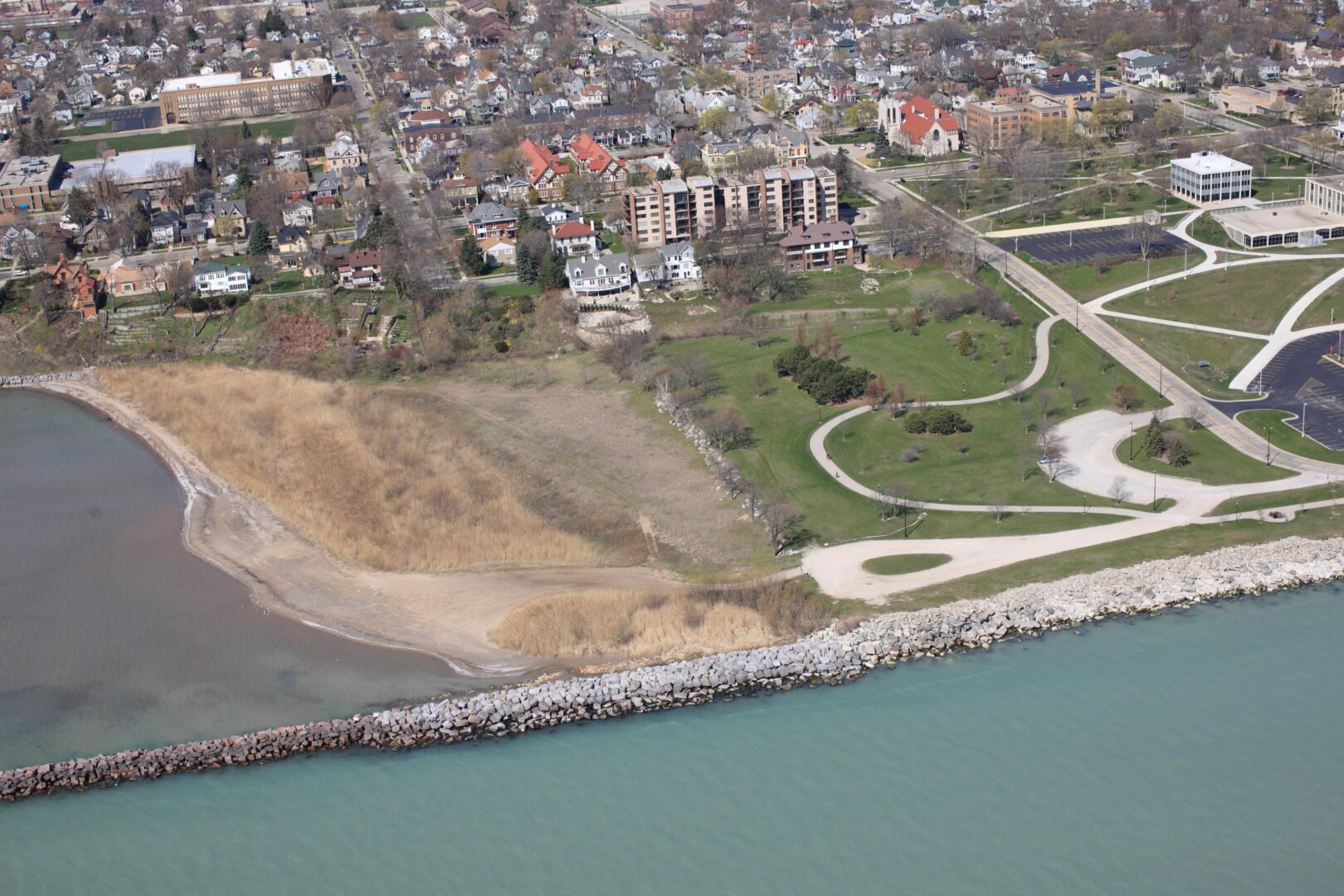
The Racine County Health Department utilized 23 different funding sources to support the phased restoration of Samuel Myers Park.
Funding the Samuel Myers Park Restoration Project
Overview
In 2014, the City of Racine Public Health Department (the Health Department) initiated a project to improve nearshore water quality, habitat, ecosystem function, and community access at Samuel Myers Park utilizing an adaptive management approach to help achieve resiliency.
Samuel Myers Park is an embayed beach in Racine, Wisconsin separated from the high wave energy of Lake Michigan by a rubble mound breakwater. The site was found to be impaired for fecal indicator bacteria and a decades long swim ban existed prior to restoration.
Priorities of the restoration project and their associated activities included:
- Improve Water Quality – Hydrodynamics of the site were improved by constructing coastal wetlands and installing green infrastructure.
- Restore Habitat – Invasive species, chiefly Phragmites, were removed. Native vegetation was established to provide food and habitat for insects and migratory birds as well as to help infiltrate stormwater.
- Increase Ecosystem Function – Capacity of the park to support both ecological and human needs was improved by implementing nature-based infrastructure, using an adaptive-management approach, and incorporating public access opportunities.
- Improve Access & Aesthetics – The project created a sense of place, community appreciation for the natural environment, and free, high quality recreation opportunities.
The Health Department utilized 23 different funding sources to support initial research and fact finding as well as construction activities. Health Department staff applied for grant opportunities and conducted outreach to secure donations.
Total Project Cost: $1,254,641
Initial Research & Fact-Finding – $84,408
Initial research and fact finding was needed to determine the contaminant sources and/or site conditions of the park that were contributing to poor surface water quality. This included water quality monitoring and modeling, stormwater monitoring, sediment sampling, and site hydrology modeling.
The Health Department was awarded a federal Great Lakes Restoration Initiative (GLRI) grant that funded 100% of the initial research and fact-finding portion of the project which cost $84,408.
Construction – $1,170,053
The total cost of construction was $1,170,053. Project implementation was partitioned into eleven phases which allowed the Health Department to secure multiple funding opportunities. Each phase was integral to the full restoration effort but could also add value to the project as a stand-alone component of the overall restoration plan. Each phase resulted in moving towards the project goals of addressing pollution, managing invasive species, restoring coastal habitat, improving site aesthetics, and creating recreational value.
| Phase | Activity |
| 1 | Raise breakwater, construct dunes, and construct and connect wetlands |
| 2 | Beach nourishment, native vegetation, canoe/kayak launch, and Mobi‐Mat™ |
| 3 | Beach nourishment, native vegetation, and cordwalk path |
| 4 | Beach nourishment, native vegetation, and cordwalk path |
| 5 | ADA compliant boardwalk, asphalt spurs, scenic overlook, and Mobi‐Mat™ |
| 6 | Extension of cordwalk path, native vegetation, and benches |
| 7 | Large scenic overlook, asphalt spurs, and educational signage |
| 8 | Gazebo, asphalt spurs, educational signage, and picnic tables |
| 9 | Native vegetation, butterfly gardens, and bird houses |
| 10 | Native vegetation, butterfly gardens, bird houses, and picnic tables |
| 11 | Native vegetation, picnic tables, and educational signage |
The Department secured money from five different types of funding sources to support the on-the-ground construction activities of the restoration Project.
- Grants: $933,000
- Donations: $63,532
- In-Kind Match: $49,178
- Tax Levy: $10,000
- Municipal Funds: $113,800
Grants
Grant funding covered the largest portion of the project costs. The Health Department applied for funding from federal, state, and local, and private grant programs including:
Federal
-
-
- Great Lakes Restoration Initiative (GLRI)
- Fund for Lake Michigan
- S. Forest Service
- S. Fish and Wildlife Service
-
State
-
-
- Wisconsin Coastal Management Grants Program
-
Local
-
-
- Root-Pike Watershed Initiative Network
- Ozaukee Washington Land Trust
-
Private
-
-
- Wege Foundation
-
The second GLRI grant was used as a seed fund for private grants that were then used to fulfill match requirements for additional federal funding.
In-Kind
Some grant opportunities require non-federal matching funds which can include in-kind work. In additional to non-federal funds, the Health Department leveraged in-kind work as match for their grant funding. In-kind work including site maintenance, park infrastructure, construction labor, engineering, surveying, and tree removal was provided by five different sources.
| Source | Service |
| Vaash & Sons Excavating | Tree removal |
| Great Lakes Civilian Conservation Corps | Site maintenance |
| AW Oaks & Sons | Gazebo foundation and construction |
| Distinctive Woodwork, Inc. | Labor for elevated walkway |
| Miller Engineers & Scientists | Engineering and surveying |
Donations
The Health Department received the following donations that supported wetland construction, park infrastructure, planting, and construction activities.
| Source | Donation |
| Racine Yacht Club | Dredged spoils and transportation of material |
| Kiwanis Club of Racine | Gazebo structure |
| Miller Engineers & Scientists | Plants |
| Ozaukee Washington Land Trust | Plants |
| Racine/Kenosha Bike Club | Bike racks |
| Lexi Kazian Foundation | Butterfly garden |
| Friends/Family of Judge Jack Jude | Tree |
| Educators Credit Union/YMCA | Bench |
| Ray Hintz, Inc. | Decorative landscape rocks |
| Friends of Myers Park | Picnic table and tree |
Cost-Effective Practices
Several cost-saving practices were utilized in this project:
- Dredged spoils from the Yacht Club were used to create the dry prairie. This saved approximately 2,000 cubic yards of soil from going to a landfill and decreased project costs by about $80,000.
- Donated plants for the dry prairie from multiple sources also helped reduce project costs.
- Salvaged limestone riprap from a legacy revetment on site was used to raise the breakwater which significantly reduced the cost of materials for that phase of the project.
Lessons Learned
- Utilize a phased approach to project components to continue adding value to the project with each phase while considering construction needs and availability of funding. This allowed the city to move forward with several smaller funding opportunities rather than have the project depend on receiving a single, large grant.
- Incorporate multiple functions into the initial site design (e.g. public access, habitation restoration, climate resiliency, stormwater management) to allow you to leverage multiple funding sources at the same time.
- The order in which funds are acquired was important. The City pursued non-federal funds first before applying to federal opportunities that require match. Having the non-federal match secured opened the number of federal opportunities that the city could apply for.




